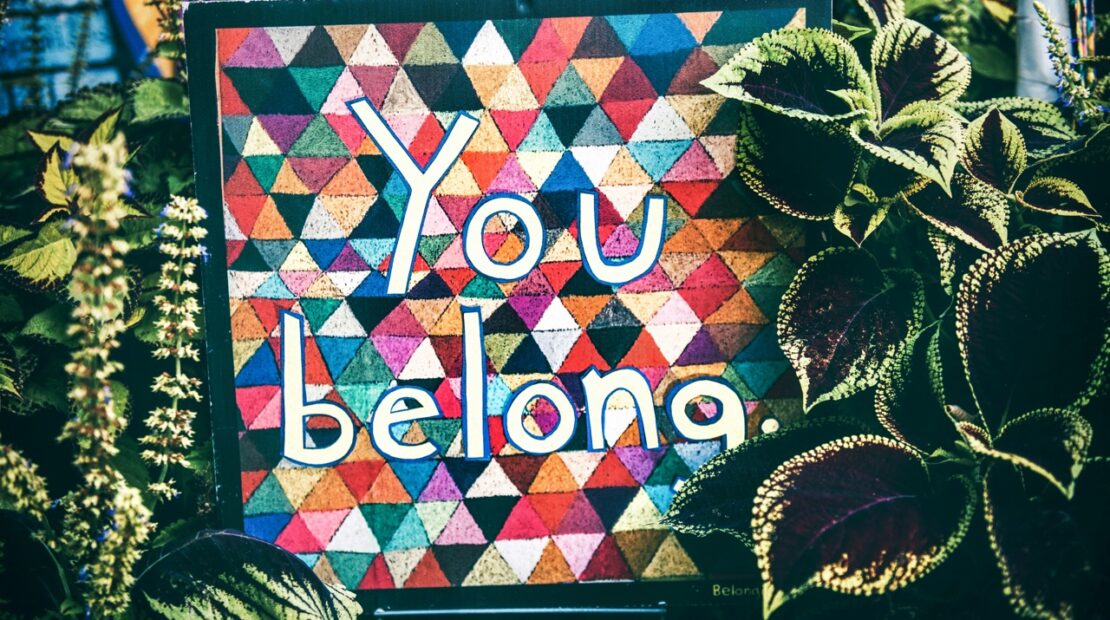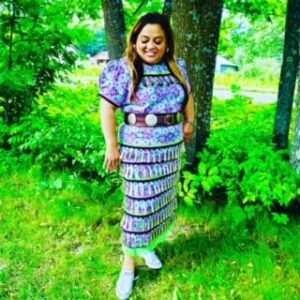
Belonging
Author
-
 Cree Rose Dueker Program Manager - Community Engagement Chippewa Cree Tribe
Cree Rose Dueker Program Manager - Community Engagement Chippewa Cree Tribe
Contributor
-
 Tawyna Stewart, Mille Lacs Band of Ojibwe
Tawyna Stewart, Mille Lacs Band of Ojibwe
For Tawnya Stewart, cultivating a Native nation rebuilding movement looks like embracing a future where every Tribal citizen feels a sense of belonging.
Story by Tawnya Stewart, an Afro-Indigenous citizen of the Mille Lacs Band of Ojibwe participating in Cohort 13 of the Native Nation Rebuilders leadership program. In addition to participating in the Rebuilders program, she is an active citizen of her nation. She currently works for Mille Lacs Corporate Ventures as the Chief of People and Culture. Outside of work, she is a mom, sister, auntie, community leader, sorority member, and so much more!
The Intersection of Cultures
Navigating the vibrant crossroads of Afro-Indigenous identity in the heart of Minneapolis has been a journey. Raised amidst the rich tapestry of African American culture by my loving relatives due to the loss of my mother at an early age, I’ve been fortunate to grow up immersed in a world brimming with dual heritage and history.
Yet, as I’ve ventured into adulthood, I’ve begun to peel back the layers of my Native American roots, discovering the intricate dance of similarities and distinctions that define my dual heritage. This exploration of “in-betweenness” — of living as a “mixed Native” — is an intriguing blend of complexity and coolness, offering a unique perspective on belonging, identity, and the richness of combining two distinct cultural narratives.
Life Through Afro-Indigenous Eyes: Let’s Have a Conversation
In the tapestry of life, my theme weaves through many colors and textures. As a mother, I nurture and guide; as a Tribal citizen of the Mille Lacs Band of Ojibwe, I carry the heritage and dreams of my ancestors. To some, I am the exceptional best friend; to others, a sister, an auntie, sharing the joy and sorrows of family history. I love discovering new places, making me a world explorer. I move to the beat of our traditional Ojibwe and House music. In corporate spaces, I stand as a voice advocating for change, carrying the strength of a survivor. My life ties the serene suburban landscapes and the dynamic pulse of city life, finding comfort in both. As a proud member of Alpha Kappa Alpha (the first Black Greek letter Organization, formed in 1908) and a hip-hop karaoke enthusiast, I embrace the power of culture, community, and expression. My journey is fueled by a passion for Native Nation Rebuilding, seeking to weave my past, present, and future together.
 My life journey has led me to embrace my identity. I’ve frequently encountered the question, “What are you?” This question sometimes calls for a brief answer; at other times, it invites a more elaborate explanation. My self-discovery has me pondering why I needed to choose a side or explain who I am. Yet, I am proud to share my mixed background. My niece’s fearless proclamation of her identity (Anishinaabe, black, white) on social media inspired me to confidently embrace and share my identity unapologetically.
My life journey has led me to embrace my identity. I’ve frequently encountered the question, “What are you?” This question sometimes calls for a brief answer; at other times, it invites a more elaborate explanation. My self-discovery has me pondering why I needed to choose a side or explain who I am. Yet, I am proud to share my mixed background. My niece’s fearless proclamation of her identity (Anishinaabe, black, white) on social media inspired me to confidently embrace and share my identity unapologetically.
W.E.B. Du Bois, a trailblazing African American sociologist, historian, and civil rights activist, introduced the concept of “dual consciousness” in 1903. This idea captures the inner turmoil of trying to blend American identity with African American heritage, feeling like two souls with conflicting identities in a society that often withholds full acceptance and rights. His insights shed light on the broader challenges of forming a unified sense of self amidst racial divisions. Reflecting on this concept made me wonder if I could be experiencing something like a “dual consciousness,” given my background of being Anishinaabe and African American. Either way, I feel blessed to be in the skin I am in because I get to experience both worlds.
The Weight of Heritage: Challenges & Conflicts
I can only speculate about the unique challenges faced by tribal members in Native communities who are navigating the complexities of being “mixed” or experiencing a sense of in-betweenness. Fostering a sense of belonging for all against a backdrop filled with untold stories, historical erasures, and governmental interventions opens the door for deeper discussions on this topic.
Jill Doerfler authored a book called “Those Who Belong,” which challenges racial and blood quantum definitions that have long constrained the identity of American Indians, both within Tribal nations and externally. She states, “This conversation is difficult but necessary for our collective existence and acceptance.” Doerfler highlights that “Tribes made their own decision on who belonged, and although there was conflict, the Anishinaabeg controlled the systems; they were able to work through their conflicts, as their sovereign right: they determined who was and was not a member of the nation.” Instead of accepting the definitions of race provided by the federal government, the Anishinaabeg continued to use their own definitions following Anishinaabe values and beliefs. “Occasionally, in testimonies, the Anishinaabeg of White Earth did use the terms “mixed-blood” and “full-blood” to distinguish among individual physical characteristics, but most often the terms denoted cultural characteristics and lifestyle choices. The testimonies provided in the investigation give ample evidence that when individuals were identified as “mixed-blood” or “full-blood”, biological percentages of blood were not a determining factor.”
To further complicate our identity history, the U.S. government defined and redefined race. The first census in 1790 included questions about racial identity. Over time, the government has tried to define and redefine how to categorize identity to gain insights into the population and those within the United States.
Today’s social scientists largely concur that race should be understood as a fluid concept shaped by prevailing social and political ideologies. Since the year 2000, individuals have been given the option to identify with multiple racial backgrounds. This change reflects the reality for many “mixed” Natives, despite possibly appearing as something other than their true identity. With changing times, there’s a growing trend towards boldly and openly expressing their true selves beyond mere appearances.
Complex History Missed
A contentious chapter in American history, The Indian Removal Act (IRA) 1830, epitomizes an era of forceful territorial expansion that detrimentally impacted the rights and existence of Indigenous populations. Notably, African Americans were also affected by this period of upheaval. Many African American slaves were forced to accompany their Cherokee, Choctaw, Creek, Chickasaw, and Seminole owners on the harrowing journey known as the Trail of Tears. These forced relocations not only disrupted the lives of Native American communities but also intertwined the fates of Native Americans and African Americans, highlighting a complex legacy of displacement and exploitation underpinned by the Act that is not taught or discussed in history classes.
Both communities have had connections and alliances in history, though these are often overlooked in mainstream education. These interactions include shared resistance against colonial and oppressive structures, intermarriage, and cultural exchanges. Continuing the journey to educate ourselves and others will help to create understanding and acceptance. “The story of Black-Indigenous or Afro-Indigenous individuals involves navigating the complexities of colorism and societal expectations and advocating for visibility within their communities.” (AspenInstitute.org).
Our racial identities can foster a sense of belonging and pride but can also be sources of conflict and division. How individuals and societies perceive and engage with racial identities is influenced by historical contexts, social norms, and personal experiences, making race a dynamic and evolving aspect of human culture.
Colonization and the Effects
As a Native Nation Rebuilder, I often think about how we approach this within our Tribal nations. How can we use our sovereignty to accelerate our need to be more inclusive of descendants in order to ensure the longevity of our people and culture.
Unfortunately, racism, an unwelcome legacy of colonization, has infiltrated our communities and ways of thinking, affecting how we interact with one another. Someone of mixed heritage may face the dilemma of not being “enough,” of either heritage. Hopefully, future generations will cultivate intentionality, inclusivity, and curiosity by embracing the diverse identities of their “Afro-Indigenous” relatives and others with mixed heritages. Being “mixed” while being a part of a Tribal nation highlights the need for continued education, open dialogue, and embracing a more inclusive understanding of identity while acknowledging and celebrating the diversity within and between racial communities.
Culture Colliding: A Convergence
Recently, I’ve observed how elements of “Black culture,” such as rap and hip-hop music, streetwear fashion, and distinctive slang, have become widely popular and adopted by various groups, reaching diverse communities, including Indigenous ones. This phenomenon has led me to contemplate the importance of appreciating these cultural expressions and deeply respecting and valuing the origins and the people behind them. I believe in the potential for cultural blending to act as a powerful, unifying force and the strength found in unity. Also, seeing individuals of mixed heritage thriving in urban settings fuels my hope for a future where all members of our Tribal communities are inclusively embraced. Our love and respect for the people themselves must match our affection for these cultural elements.
Enhancing Our Cultural Competency
The Intercultural Development Inventory (IDI) provided by IDI, LLC | Intercultural Development Inventory (idiinventory.com) is a guide to shifting our perspectives from states of denial or polarization towards broader horizons of acceptance and adaptation. This shift encourages people to move beyond merely glossing over the distinct experiences of a mixed community and towards fully accepting and adapting to them, potentially diminishing misunderstandings and promoting inclusiveness.
By enhancing and enriching our cultural competency, we position ourselves to absorb new insights and discard outdated narratives, thereby seeking truth and ensuring every Tribal member feels a sense of belonging. By increasing cultural competency, we can learn and unlearn harmful narratives while seeking truth and opening the door for all Tribal members and descendants to belong.
Embracing our seven Ojibwe teachings of honesty, truth, respect, humility, bravery, wisdom, and love helps us build a roadmap for future generations. Our ancestors cultivated values that equip us to converse about identity, culture, belonging, and acceptance.
Initiatives to Foster Awareness: Social, Cultural, and Inclusive Engagement
- Educate Ourselves and Others: Commit to learning about the rich histories, cultures, and contemporary issues facing Native American and African American communities. Seek out authentic sources, voices, and people who represent this experience.
- Engagement: Engage with and support initiatives led by Native American and African American communities, whether they focus on cultural preservation, social justice, or economic empowerment.
- Education: Include Native American and African American histories and perspectives in educational curricula at all levels, promoting a more comprehensive understanding of history.
- Love: Show love and be a kind human.
Reflection
As a Native Nation Rebuilder, I am optimistic about creating a more inclusive future where every Tribal citizen is embraced. Those who identify and live in the “in-between” or identify as a “mixed Native” embrace their uniqueness and cultures without choosing one over the other.
I have come to realize a few things: African Americans and Native Americans share complex histories marked by solidarity, systemic discrimination, and a deep sense of community. Both groups have been shaped by cruel legacies and despite these adversities, there’s a strong emphasis within these communities on education, learning rich histories and cultures, as well as a relentless fight against racism and cultural erasure. This includes combating stereotypes and misrepresentations while showing resilience in the face of displacement from ancestral lands and struggles for civil rights. Both communities take immense pride in their heritage, actively seeking justice and healing.